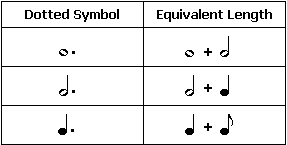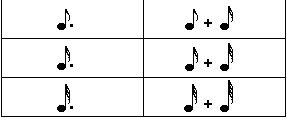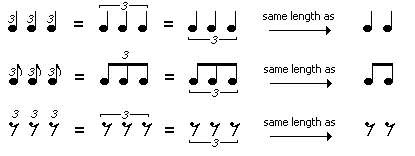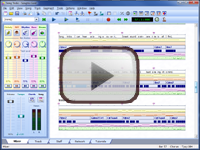(5.7) Note Length Modifiers
We have a series of note symbols available to us, which can cover the range from very short notes to very long. However, each symbol is half or twice the length of its neighbour, and these are large differences.
Often we need to notate lengths in between the available symbols. For example, consider the folk song Kum Ba Yah, notated below.

You can see that we need to show, in several places, notes of one and a half quarter-notes in length. But no such symbol exists, so we must tie together a quarter-note and an eighth-note to achieve the correct length.
This is perfectly acceptable notation, but we can also write it in another, simpler way. The length of any note symbol can be extended by an extra half when followed with an augmentation dot.
The table below shows the equivalent length of the augmented symbols. You will rarely see a dotted whole-note, as it is longer than the bar size of most commonly used meters.


You might recall we saw an example of augmentation dots in an earlier topic, with the Skater's Waltz. Now let's see how much neater Kum Ba Yah looks when notated in this way.

ChordWizard products such as Songtrix offer the optional use of augmentation dots when they prepare staff notation for you.
If enabled, augmentation dots will be used wherever possible, otherwise separate note symbols, joined with a tie, will be used for notes of non-standard length.
Another type of modifier is needed when we try to notate triplets, a very common rhythm in music. Listen carefully to the passage below (in 4/4 meter) and you will hear that three equal notes are being played in the space of one beat.

This simply can't be notated with the symbols we have learned so far. We need a symbol length which is one third (33.3%) of a quarter-note. An eighth-note is one half (50%) of a quarter-note, a dotted sixteenth-note is three eighths (37.5%) of a quarter-note, and nothing else comes close.
The solution lies in adding a '3' (or triplet) sign to a symbol. This has the effect of fitting three of the symbols into the space of two. In other words, it makes a symbol 2/3 of the length it would normally be.
Notice how the triplet sign is applied to single notes, beamed groupings and rests.

Using this extra triplet modifier, we can notate the passage above as follows:

One final word on note lengths before we move on. As we have seen, staff notation is very much based on the idea of splitting time into exact fractional parts, which form the boundaries of where notes and rests begin and end.
However in practice, performed music never starts or ends on the precise fractional boundaries that the notation indicates. We are human musicians, not robots, and there is always variation in the precise timing of the notes we play.
This is a good thing. The variations in timing (and loudness) of notes in performed music is what allows musicians to layer their own expression on top of the notated melody. The listener's ear can still pick up the basic rhythm, but the variations (if not too large) add a pleasing 'fuzziness' to the timing of the music that actually enhances it.
This is quite noticeable with computer music where notes have been entered on these exact boundaries via editing, rather than playing. Although the music is then perfectly accurate to the notation, it can actually sound quite rigid, mechanical and expressionless.
To overcome this, most music software has a humanize or randomize function which specifically adds a little bit of randomness to the positions and lengths of the notes, making it more 'realistic' and satisfying to listen to.
ChordWizard products such as Songtrix offer a Humanize function, which can add a controllable level of randomness to either the positions or lengths of notes, or both.
















